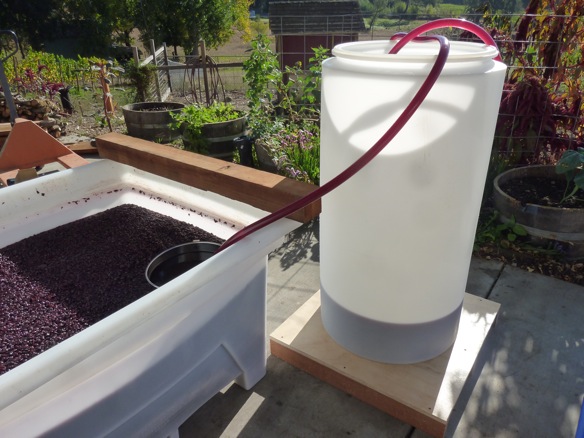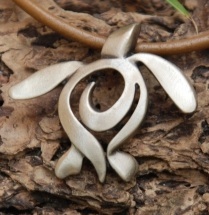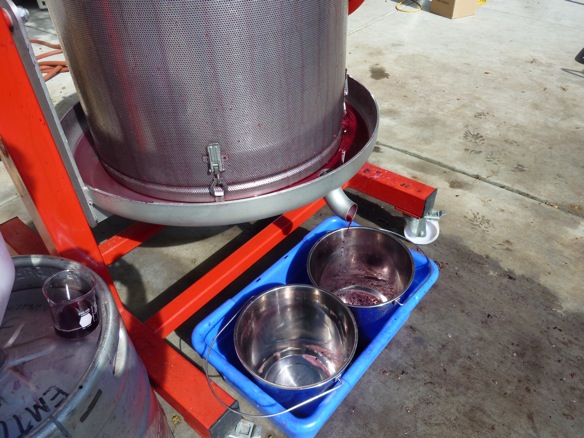 Pressing grapes on a small scale is so much fun! If you have been following along, we harvested grapes, cold soaked them for 6 days, then fermented them for 9 days and now after all the sugar has been converted to alcohol, and the must (grapes) have gone silent we press off the skins and seeds and only get juice. In the picture below you will see that we first siphon off the liquid on the bottom into your container. Then you take a bucket and get the wet grapes into the bladder press. All of the wine that is now in your container is called the “free run”. It is the most tart, lightest color and has the lowest pH. Many winemakers keep this separate when they perform malolactic fermentation, racking and aging of the wine. It is then blended into the other wine for balance or in many cases kept apart. All part of the winemaking art! Now you turn on the press and start to get juice from the grapes. This will take about 1-2 hours, depending on the strength of your press. In our case we had 80 gallons of free run and 27 gallons of pressed wine. Lastly, if you are there when the press is nearing the end, the wine is very dark and rich.
Pressing grapes on a small scale is so much fun! If you have been following along, we harvested grapes, cold soaked them for 6 days, then fermented them for 9 days and now after all the sugar has been converted to alcohol, and the must (grapes) have gone silent we press off the skins and seeds and only get juice. In the picture below you will see that we first siphon off the liquid on the bottom into your container. Then you take a bucket and get the wet grapes into the bladder press. All of the wine that is now in your container is called the “free run”. It is the most tart, lightest color and has the lowest pH. Many winemakers keep this separate when they perform malolactic fermentation, racking and aging of the wine. It is then blended into the other wine for balance or in many cases kept apart. All part of the winemaking art! Now you turn on the press and start to get juice from the grapes. This will take about 1-2 hours, depending on the strength of your press. In our case we had 80 gallons of free run and 27 gallons of pressed wine. Lastly, if you are there when the press is nearing the end, the wine is very dark and rich.
Category Archives: Wine Making
Barrels
It was a great growing year for grapes, and the economy is coming back….so I should have known that everyone would have bumper crops and a barrel would be very difficult to come by.
First…why a barrel? It has to hold wine, breath and impart slight oak flavors. Most winemakers use about 30% new oak and then the rest 1 and 2 year old oak barrels. The older the barrel the more “neutral” it will be and won’t impart a lot of taste. So, with only a little over a barrel, I was looking for a 1 or 2 year old barrel. I called and visited about 30 wineries and custom crush facilities in the area, called Washington, Oregon, Colorado and even Canada. No used barrels. In the picture below my friend and winemaker John Mason tried to get some 2002 barrels to hold water but to no avail.
So, the same company that made my fermentation tank makes a plastic breathable barrel replacement. All you have to do is add oak staves (pieces) and they claim it is almost the same as a barrel with the added benefit of being able to clean it much easier, it can be sealed an pressurized with nitrogen and it has a sample port. So…necessity is the mother of invention.
Potassium
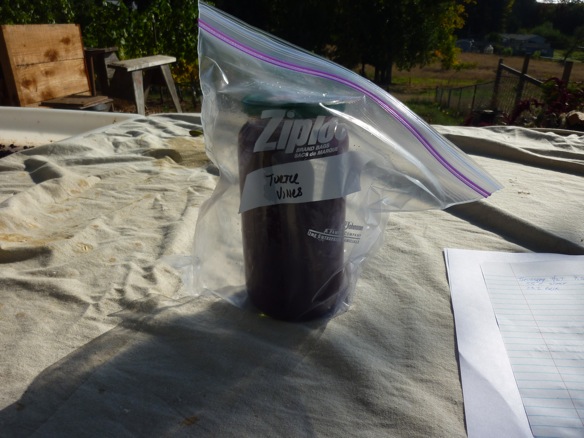 Why is this important? Most vineyards show potassium deficiency, however young vines in many cases produce berries high in potassium like our did, >2,000 ppm. An easy explanation….watering techniques. Early in the season, wen the growth rate is high, much of the potassium accumulates in the leaves. Then the potassium ions are moved from the leaves into the berries later in the season when the fruit starts to ripen. How is this controlled? Try not to water from the time the berries “set” on the vines to verasion (when they turn purple). This will limit the amount of potassium into the leaves that will be transferred to the berries. Due to the smallness of our vines and the shallow roots, I had to water them so they would be healthy. This, I think, shot up the potassium which in turn increased our pH of the berries later in the season. So, next year I will try and not water until verasion.
Why is this important? Most vineyards show potassium deficiency, however young vines in many cases produce berries high in potassium like our did, >2,000 ppm. An easy explanation….watering techniques. Early in the season, wen the growth rate is high, much of the potassium accumulates in the leaves. Then the potassium ions are moved from the leaves into the berries later in the season when the fruit starts to ripen. How is this controlled? Try not to water from the time the berries “set” on the vines to verasion (when they turn purple). This will limit the amount of potassium into the leaves that will be transferred to the berries. Due to the smallness of our vines and the shallow roots, I had to water them so they would be healthy. This, I think, shot up the potassium which in turn increased our pH of the berries later in the season. So, next year I will try and not water until verasion.
High pH/High Titratable Acid?
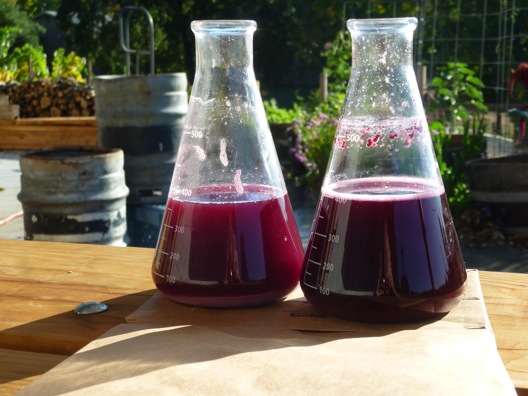 I learned so much this year in farming…but not as much in all the items I had to monitor prior to harvesting and in making good wine. I was looking at sugar content (around 23.5 to make 13.5% alcohol wine), seed color as the browner will tell me that the phenolics (ripeness) are ready but I didn’t monitor the pH. Why is that important? In a finished wine you want around 3.6 pH so that it will taste smooth but also age. The higher the pH the harder it is to age and the more sulfur you have to add when the wine is aging and in the bottle so it does not spoil. Therefore, you want your grapes at harvest to be around 3.4 because during fermentation, pressing and malolactic fermentation it will rise 0.2-0.3 units. When we picked the pH was 3.9 so I added tartaric acid to bring the pH closer to 3.7 before fermentation. Hopefully that is low enough.
I learned so much this year in farming…but not as much in all the items I had to monitor prior to harvesting and in making good wine. I was looking at sugar content (around 23.5 to make 13.5% alcohol wine), seed color as the browner will tell me that the phenolics (ripeness) are ready but I didn’t monitor the pH. Why is that important? In a finished wine you want around 3.6 pH so that it will taste smooth but also age. The higher the pH the harder it is to age and the more sulfur you have to add when the wine is aging and in the bottle so it does not spoil. Therefore, you want your grapes at harvest to be around 3.4 because during fermentation, pressing and malolactic fermentation it will rise 0.2-0.3 units. When we picked the pH was 3.9 so I added tartaric acid to bring the pH closer to 3.7 before fermentation. Hopefully that is low enough.
Oh, almost forgot…the higher the pH the lighter the color. So, I added pectic enzymes to the must during cold soak to enhance the color. The top picture is with and without enzymes. Pretty impressive so far, will have to see how it turns out in the finished product.
Refractometer
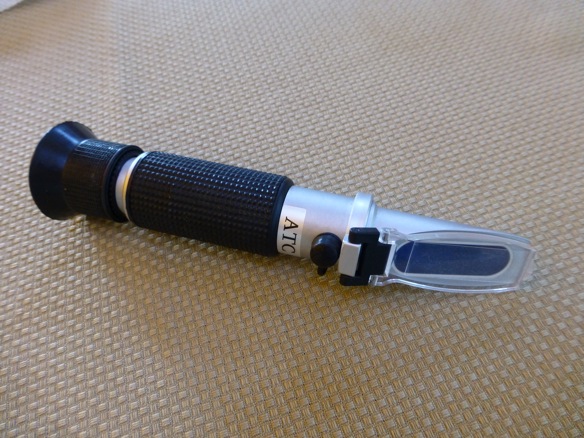 It has finally come time to measure the sugar content of the grapes, hope they ripen evenly and then harvest and make wine.
It has finally come time to measure the sugar content of the grapes, hope they ripen evenly and then harvest and make wine.
Think back to your chemistry days where you had different tools to measure chemical content of liquids….or is that only me with my Chemical Eng background? Anyway, there is a very simple tool called a Refractometer that will measure the sugar content of the grapes.
In the picture above you can see that you simply squeeze the grape and put the liquid on the glass window and cover it with the lid. Then you look into it like a kalaidascope and a line will appear on a scale and you will know the content. Hard to explain on paper, but easy to do.
In the vineyard you now have to measure a good number of samples every week until you get to the desired sugar level. I’m shooting for 23.5% that will give me a wine with a little under 14% alcohol.
In addition, for the flavors you can tell if the grapes are ripe by the color of the seed. If the seed is green it isn’t ready. If it is brown…..good to go.
To Wine or not to Wine, that is the question?
The making of the wine is fairly straight forward but the selling is a full time job. Still have to discuss with wine makers on costs….so who knows. The woman who owns Silver Oaks recommended that we sell grapes the first few years…..same advise I got 2 weeks ago at a wine event. So….stay tuned. Of course the first year we will get between 25 and 50 cases (we hope) so most of that will go to friends and family and perhaps some wine competitions.
If we do make wine here are some thoughts on bottles/labels/corks.
Making wine – in previous posts you may have read that we are interviewing people to make or buy our grapes. Looks like they will come to Turtle Vines the end of June. Very excited to show off our work so far.
Bottles/corks/labels – below is a picture we saw of a turtle necklace. We are hoping to use this design for our label. In addition, we like the spray painted lables on bottles. Not traditional, but they look nice and you don’t have to worry about lables falling off. Lastly…..and certainly not traditional…..glass corks. I like the look of them and the wine will not get “corked”. Only issue is that the wine ages much slower as the air goes into the bottle about 10x slower than corks.
By the way….the picture above is from Sausalito where we sat the other night with a few glasses of wine after being in San Francisco.
Single Vineyard Night
 We enjoyed a wonderful evening at “Single Vineyard Night”, hosted by the Thomas George Winery. It was put on by the younger generation of winemakers/vineyard owners and the event was in their caves. If you have never been in a wine cave, it is a treat! We went to enjoy the wine and try and determine what to do with our grapes starting in 2012.
We enjoyed a wonderful evening at “Single Vineyard Night”, hosted by the Thomas George Winery. It was put on by the younger generation of winemakers/vineyard owners and the event was in their caves. If you have never been in a wine cave, it is a treat! We went to enjoy the wine and try and determine what to do with our grapes starting in 2012.
Well….we could just grow grapes and then sell them to a like minded winery to make wonderful wine. Sounds pretty easy…..but we are just starting out so we don’t have a reputation yet….except we are in the Russian River Valley. And of course…..we planted Pommard and 667 at the proper angle spaced densely to stress the vines and make intensely flavored wine….or that is the theory!
Or…..we could have someone help us make the wine and then sell it. If you are reading this…send a note and I can put you on the first allocation. The 2012 vintage will produce 25-50 cases. Enough for friends/family the first year but then it will peak at 250-300 cases for the 2015 vintage. Selling that much wine will take some effort…..good financially if it works out but a lot of work.
Maybe a combination of both? Who knows…..but with this evening and another event hosted by Justin Lattanzio that we are going to on June 11, 2011…..will have more information to give us a good direction to head. It would be nice to make that decision early….but with this economy, who knows.
Pressing Grapes – Almost 7 Gallons of Pinot Noir
 The grapes fermented for a week and on Saturday Oct 17th the hydrometer reading got to zero! We were ready to press and put the “wine” into a large 7 gallon carboy. Joey, Cody and I spent about 3 hours pressing, filtering, cleaning to get our first vintage ready. It will now sit in the carboy for about a month until it goes still, or stops the last bit of fermentation. During this period of time the sediment (lees) will fall to the bottom. We will then transfer this to a smaller containers 3 more times and take out the sediment so that we have clear wine. Of course, we will have to taste it to make sure it is OK and make sure it is good to bottle in about 6 months. In the next post I will detail the readings we took in case anyone is interested.
The grapes fermented for a week and on Saturday Oct 17th the hydrometer reading got to zero! We were ready to press and put the “wine” into a large 7 gallon carboy. Joey, Cody and I spent about 3 hours pressing, filtering, cleaning to get our first vintage ready. It will now sit in the carboy for about a month until it goes still, or stops the last bit of fermentation. During this period of time the sediment (lees) will fall to the bottom. We will then transfer this to a smaller containers 3 more times and take out the sediment so that we have clear wine. Of course, we will have to taste it to make sure it is OK and make sure it is good to bottle in about 6 months. In the next post I will detail the readings we took in case anyone is interested.
De-stemming grapes for our own wine – Generously donated grapes
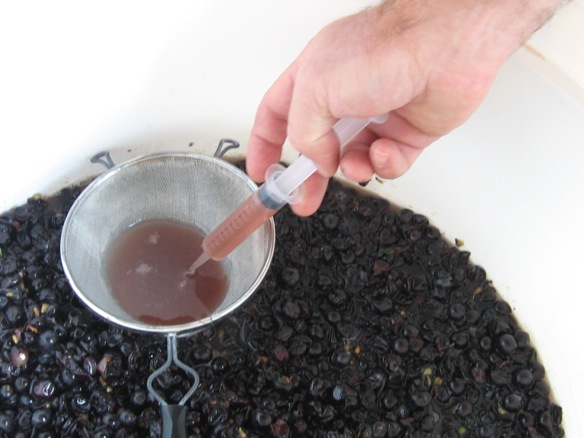 We are going to try and make our own wine this year. We went today to EMTU to pick about 70 pounds of grapes and use the kit that our nephew gave us to make 6 gallons of wine (30 bottles). We hope we will have some wine to drink in about a year. This will be the first of 3 practice batches before we have our own grapes.
We are going to try and make our own wine this year. We went today to EMTU to pick about 70 pounds of grapes and use the kit that our nephew gave us to make 6 gallons of wine (30 bottles). We hope we will have some wine to drink in about a year. This will be the first of 3 practice batches before we have our own grapes.
Chris took this picture of all of use doing it the old fashioned way, taking the grapes off the rachis (stems) by hand. We then put them in the white food grade 20 gallon pail….tested for and adjusted the acid. We started at 0.65 and we wanted 0.75. We also added about 30 ppm of sulfur. We will let it sit for 2 days and then add yeast for it to ferment. Should take about a week and then we crush.
Pressing Grapes at EMTU with john and chris mason
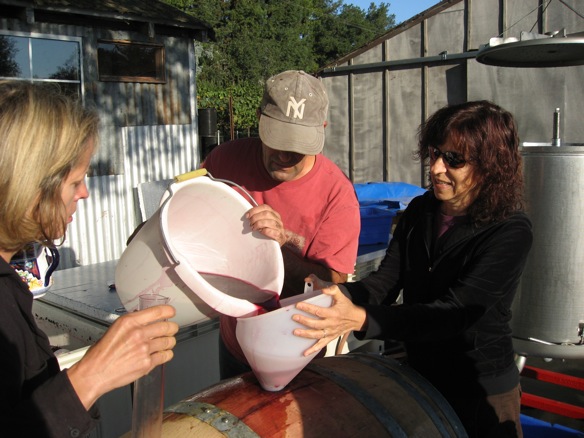 Last week we helped our friends John and Chris Mason at EMTU pick Pinot noir at their vineyard in Forestville. Today they were kind enough to let us help them with the pressing of 1/2 ton of grapes and barrel them. We all did 2 barrels, or enough for around 550 bottles.
Last week we helped our friends John and Chris Mason at EMTU pick Pinot noir at their vineyard in Forestville. Today they were kind enough to let us help them with the pressing of 1/2 ton of grapes and barrel them. We all did 2 barrels, or enough for around 550 bottles.
They are doing their wine in small lots so this is a process they will do a few more times in the next couple of weeks. I hope you can see from the pictures that the wine has a wonderful color and I’m sure will make great wine…..you should get some of their 2007 Pinot noir when it comes out in a few months as it is very special.
